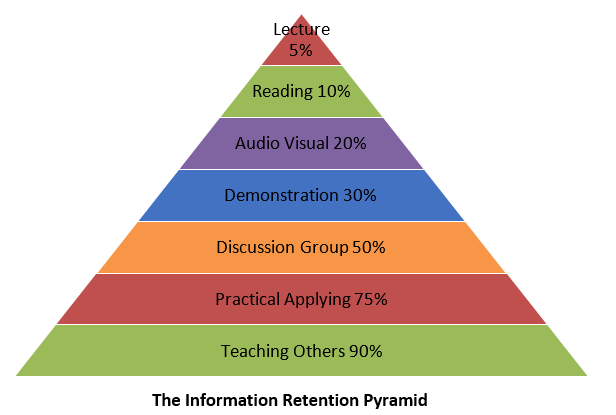The course’s quality depends on the acquired information retention rate. This article's Part I offered in-depth details on retention definition, how it functions, what influences it, and a set of techniques that help enhance it. This part will discuss the remaining techniques, so keep reading.
Memory Retention Improving Techniques
5. Interactive Components
Content should foster engagement and interaction to boost employees' information retention effectively. These interactive components include webinars, quizzes, brain games, group discussions, and simulation exercises.
Interactive components outperform traditional information delivery methods that lack engagement opportunities. Therefore, the content should be visually appealing, practical, and customized to the trainees’ needs to help them comprehend and retain the information.
Scenario-based learning enhances the training's enjoyment and effectiveness, improving employees' retention abilities. Real-life cases and simulations can also be used to assess critical thinking and decision-making skills in various workplace situations, ultimately increasing the training's impact and information retention.
6. Learning from Mistakes
Everyone makes mistakes in both personal and professional contexts, but mistakes during training can be leveraged to improve employees' ability to retain information.
Employees can benefit from their mistakes in self-development if they are open to learning from them.
Sometimes, mistakes can have severe consequences that negatively affect work processes, systems, and people in the environment. These mistakes become ingrained in the employee's memory, preventing them from repeating them in the future.
Such mistakes should be viewed as opportunities for learning and growth, prompting necessary adjustments in ineffective work procedures.
7. On-the-Job Learning
Training becomes more effective when integrated into daily work activities, improving employees' information retention. This approach is effective because it allows employees to learn and apply new knowledge while performing their tasks simultaneously.
Learning opportunities are constantly available in this scenario, allowing employees to apply the acquired information immediately.
Employees' retention of information is further enhanced when they receive quick and accurate answers from the company's knowledge base, for example.
8. Assessments
Assessments and tests help enhance retention ability. They aim to familiarize trainees with new information, its applications, and how it integrates into daily tasks. These assessments help track learning pace, progress, and any challenges encountered during training, ultimately aiding retention.
It is advisable to incorporate assessment systems into training courses while focusing on interactive aspects to encourage trainees to complete the assessments.
Post-training assessments aim to assist trainees in developing their cognitive abilities and solidifying information in long-term memory.

Case Study
Trainer Ali Habib specializes in working with elementary school children.
His challenge: Trainer Ali Habib complained about the lengthy process of sharing course materials with elementary school children and expressed the need for a program to help him organize tasks and create interactive assessments.
The solution: Trainer Ali used a program to develop training courses and assessments, streamlining his training procedures significantly.
These technological tools facilitate the creation of electronic assessments, boosting students’ engagement and encouraging them to participate. These tools provide exercises and activities that assist trainees in understanding and retaining information easily, leading to an increased retention rate throughout the year.
Results Achieved: A marked improvement in participants' study habits and ability to easily solve tests at home.
9. Training Others
Scientific research confirms that individuals learn and master a subject best when explaining and teaching it to others, which also enhances research and communication skills.
This teaching approach can be incorporated into employee training programs through peer learning initiatives, QA forums, and brainstorming sessions among team members.
Such activities boost the effectiveness of information acquisition by facilitating knowledge sharing. Teaching also enhances retention ability because it encourages creative interaction with training materials.
10. Practical Applications
Employee training aims to achieve specific practical outcomes. Research has demonstrated that the human brain's ability to retain information diminishes when it doesn’t align with its needs or context. Therefore, developing training plans that consider trainees’ roles, needs, and life circumstances is essential.
These measures help improve retention ability. Therefore, it is recommended to clarify the course’s objectives from the early stages and explain its benefits and role in enhancing trainees’ professional lives.
Such measures foster greater interest in the course and enhance information retention.
The Information Retention Pyramid
The National Training Laboratories issued the Information Retention Pyramid during the 1960s, which classifies retention rates based on various learning methods.
This pyramid illustrates how much information is retained depending on the training techniques used.
According to the model, lecture-based learning has the lowest retention rate at 9%, while teaching others can lead to a retention rate of approximately 90%.
This pyramid helps implement effective training strategies that enhance employees' retention ability over the long term.

Frequently Asked Questions
1. What distinguishes memory from information retention?
Memory refers to the brain's mechanism for storing and retrieving information when necessary and the ability to recall it after some time. It relates to the knowledge acquired about a person or subject.
In contrast, retention refers to storing information in long-term memory so that an individual can use it later. It is essentially retaining information over an extended period.
This means that memory can be short-or long-term, while retention is always long-term.
2. How does the retention process occur?
Retention relies on attention and cognitive engagement. Initially, an individual focuses on a piece of information, a person, or an object and then reflects on it. Concentrating on the topic of interest is crucial for effective learning and retention. Also, actively participating in training activities enhances understanding, retention, and recall.
3. How can retention ability be assessed?
The most effective way to assess retention rates is through electronic assessments and tests that employ various formats and question types. Tests can be added to evaluations at the end of the training course and used at all training program stages.
In Conclusion
Trainers aim to help trainees absorb and retain as much information as possible so that they can apply it in their daily tasks.
Achieving this goal involves understanding how memory and retention function, examining the factors influencing them, and employing the methods discussed in this article to improve employees' information retention abilities.
Improvement plans for retention ability may include interactive e-learning courses and a simple, user-friendly Learning Management System (LMS).











